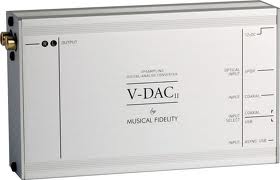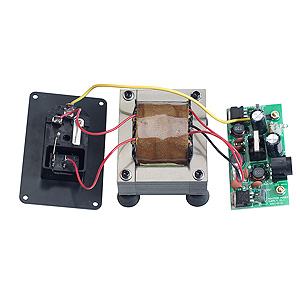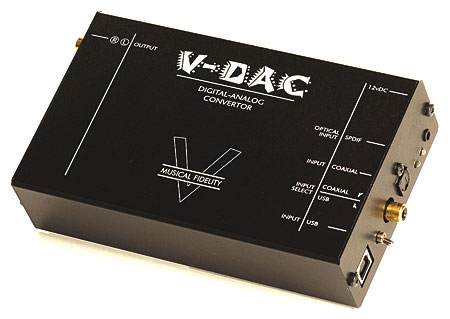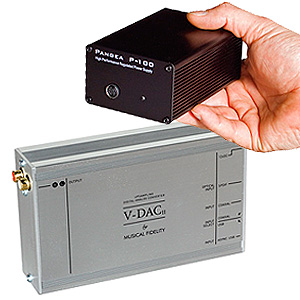by Brad Easton and Kevin OBrien on 03/08/2012
MUSICAL FIDELITY V-DAC VS. V-DAC II
We recently decided to upgrade from our Musical Fidelity V-DAC to the newer V-DAC MkII. We'd like to let our readers know about the main differences between the two in case anybody is in the market for the new version. We paired the older V-DAC with our CD transport and various computer transports to show our readers there is an affordable way to get into USB based computer audio without breaking the bank.

The original V-DAC is no slouch. I have to say it definitely sounds better than the older MF DAC's such as the A3.24 from circa 2002. According to MF, it even outperforms any of the slightly older DAC's such as the X-DACv3 and even the Tri Vista 21 Tube DAC. Although I'd probably take a Tri Vista 21 over any of the other older MF DAC's based on its tubed output. If it were up to me, I'd go with V-DAC over the older designs based on its USB input and updated processing which the older designs lack. There's probably one exception: Let's say you have a tubed DAC that you love and want to add USB capabilities. That's where the V-LINK comes in but we'll save that discussion for another time. Right now, we're focused on the two MF DAC's, not their USB to SPDIF converter!

Let's touch on the main differences between the two DAC's before we go any further. After checking the Musical Fidelity website, we learned the basic differences. The finish/ overall look of the V-DAC has been upgraded to a nice silver case vs. the old plain black case. The USB input has received a kick in the pants by adding an Asynchronous USB input instead of the original Adaptive USB input. The older version was stuck at a 16/44 input ceiling for digital files where the newer version has been bumped up to accept 24/96 digital files. NICE! The older version had a distortion value of 0.005% where the new version has dropped down to 0.002%! Stereo separation has also increased on the new model to -105dB.
We have to say the biggest selling point to us was the inclusion of an Async USB input and the upgraded 24/96 native resolution. We were downsampling our digital files with the original V-DAC. Remember, even though our Hi-Res files were downsampled, we still unanimously agreed they sounded better than the Red Book 16/44 files played through the same DAC and digital player. We don't have to do that with the new version and we can actually upsample ALL our digital files to 24/96 if we like. We choose to send the files through to the DAC at their original sample rate. We don't like to upsample/ downsample our files if at all possible.

It's important to note that we went with the Pangea P-100 external power supply mated to the V-DAC II instead of the Pyramid PS-3KX external power supply we used with the original V-DAC. Any external power supply will better the included wall wart. The P-100 is the better unit if you're deciding between the Pyramid and the Pangea. Let's keep in mind both power supply units are of the switching variety and NOT linear power supplies. If you'd like one of those, we could make you one or you could purchase one from Teddy Pardo.

Well, let's talk about the sound of each unit. The original version sounds great with an external power supply. You don't have to spend a lot to upgrade the wall wart that's included. We spent about $25 on the Pyramid. As we stated before, the original V-DAC bests the older MF DAC's, even the Tri Vista 21 Tube DAC. (Though that's still up for debate) Now on to the new version, the V-DAC II. I have to say it definitely sounds better than the original. We are comparing both units with a CD transport as a source first. There is definitely a noticeable difference between the two. I feel an audiophile would be able to tell the difference right away. A non-audiophile may not be able to tell right away but I think he or she would eventually hear the value in the upgraded unit.
If you'd like us to describe what we're hearing, we would say the MkII puts out an overall better soundstage, deeper bass, better mids/ highs, and more detail. Again, it's hard to quantify but the difference is there although it is a slight difference. Obviously your mileage may vary depending on your system.

Now onto the USB input. This is where the MkII shines. We can now run our digital files in their native resolution, whether it's 16/44, 16/48, 24/88, or 24/96. We still have to downsample our 24/176 and 24/192 files to 24/96 within JRiver but how many albums are out in that format right now anyway? Not many! (See our JRiver Review which shows the user how to handle various file formats) We can now implement multiple bit-perfect playback modes since the MkII has an updated Asynchronous USB input. We are referring to the multiple bit-perfect output options within JRiver which are ASIO, WASAPI, WASAPI - Event Style, and Kernel Streaming. Each output mode should allow the user to fine tune the sound to his system and liking. Show me a CD transport that can do that! The above descriptions on sound and performance hold true for the USB input as well. The main difference is that the V-DAC II can now handle the various current bit-perfect playback modes. YES!
It's great to step into the current USB technology playing field. The original V-DAC was a great little DAC but the V-DAC II has raised the performance bar even higher. Musical Fidelity really has a winner on their hands here. We've heard around the campfire that the MF M1-A DAC is the same as the V-DAC II but with a built-in power supply in one box. You can try the MF M1-A DAC if you really want to but I'd go for the above-mentioned set-up and save yourself $300! (OR, find a used EE Minimax DAC for ~$700). You don't get the AES/EBU digital input, XLR analog outputs, or the choke regulated power supply but do we really need those in this price range anyway? You can get a custom, non-switching power supply from Teddy Pardo for ~$350 which brings the V-DAC II up to/ surpassing the M1-A DAC's performance level for ~$50 less. Personally, I like when the power supply is away from the main processing components since this method keeps both sections isolated from one another. You make the call!
THANKS for reading and keep on listening!
-BJE, KOB
Associated Equipment for this Review:
- YFS HD-Ref-1
- McCormack SST-1 CD Transport
- YFS Custom Direct "Passive" Preamp and Custom 6L6 Tube Power Amp
- YFS/SCH K08T21 Custom Speakers
- YFS Custom Interconnects, Cables, and USB Cables
- YFS Custom Room Treatment
